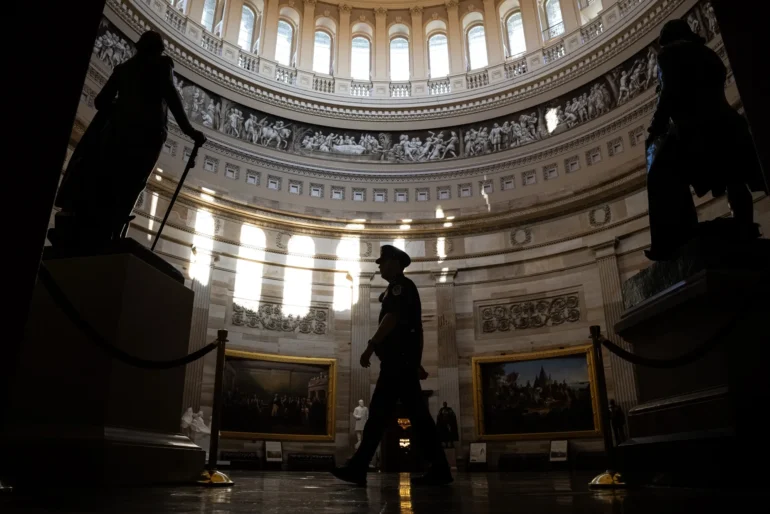After 43 grueling days—the longest government shutdown in American history—Congress finally passed a spending package late Wednesday night, reopening federal agencies and ending a bitter standoff. President Trump signed the bill into law, but the deal leaves many questions unanswered about health care, federal workers, and future political battles. Here’s a clear breakdown of how we got here, what the agreement includes, and what might happen next.
Why the Shutdown Began
The roots of this crisis trace back to Democratic frustrations with past compromises. In March, Senate Democratic Leader Chuck Schumer faced intense criticism from his party’s progressive base for agreeing to a Republican-backed spending bill that many on the left viewed as unacceptable. This time, Schumer teamed up with House Democratic Leader Hakeem Jeffries to take a harder line. They demanded extensions for health care subsidies, warning that without them, tens of millions of Americans would face sharply higher insurance premiums.
Democrats refused to fund the government without these protections, leading to the shutdown on its start date earlier in the fall. The standoff highlighted deep divisions, with the party’s base pushing leaders to fight harder against Republican priorities under President Trump.
How It Ended—and What Was Sacrificed
The breakthrough came Sunday night when eight moderate Democratic senators broke ranks and joined Republicans to reopen the government. These senators argued that President Trump and GOP leaders showed no willingness to negotiate, and the human cost had become unbearable. The Trump administration bet correctly that Democrats couldn’t tolerate the pain inflicted on everyday people, including 42 million recipients of the Supplemental Nutrition Assistance Program (SNAP, or food stamps) and over 3 million unpaid federal workers.
Critically, the deal did not include the health care subsidy extensions Democrats fought for. Progressives quickly accused the moderates of caving, but the senators insisted further holdouts would only cause more unnecessary suffering without any GOP concessions.
What’s in the Spending Bill?
The legislation funds the government through January 30, 2026, with special long-term protections (until September 2026) for key programs:
- SNAP benefits
- WIC (Women, Infants, and Children nutrition program)
- Department of Veterans Affairs
- Congress itself
It also addresses the shutdown’s toll on federal employees by reversing recent mass layoffs and restoring lost pay. However, this could become leverage in future fights if another shutdown looms after January 30.
Other notable provisions include:
- Increased security funding for Congress, executive officials, judges, and Supreme Court justices—prompted by the recent assassination of conservative activist Charlie Kirk.
- A controversial clause allowing senators to sue the Justice Department for $500,000 each if subpoenaed or if their phone records are accessed in the ongoing January 6 investigation. House Republicans have vowed to repeal this, but success is uncertain.
- Hundreds of earmarks—local projects slipped into the bill without formal votes. Examples range from equipment for a Virgin Islands college and a new veterinary doctorate program at the University of Maryland Eastern Shore, to urban forest conservation in Texas, asbestos removal in Alaska, and funding for hospitals, fire stations, and youth centers nationwide.
Intra-party drama surfaced too: Kentucky Republican Senators Mitch McConnell and Rand Paul clashed over hemp regulations.
Risks of Another Shutdown
With funding expiring January 30, a repeat crisis is possible. It hinges on:
- Whether Democrats learn from this experience and unify.
- If progressive anger cools.
- Pressure for a standalone vote on health care subsidies.
Without extensions, premiums could skyrocket for millions—a outcome Republicans would “own” in voters’ eyes, especially in an election year.
Impacts on Workers, Travel, and Health Care
Federal workers are returning to their jobs, with furloughs ending and back pay incoming. Airport delays, caused by absent air traffic controllers, should ease in the coming days, though Transportation Secretary Sean Duffy warned of short-term flight cuts at major hubs.
The bigger unresolved issue is health care. House Speaker Mike Johnson has refused to commit to a vote on subsidies. Moderate Democrats hoped for one, but if subsidies lapse, Republicans will likely bear the blame for rising costs—a potential boost for Democrats in the 2026 midterms.
Surprises and Side Stories
The bill’s fine print revealed quirks, like the senator lawsuit provision and earmarks spotlighting “pork-barrel” spending. One future vet might even thank this deal for their University of Maryland degree.
The shutdown’s end also advanced a push to release Jeffrey Epstein files. Newly sworn-in Arizona Democrat Adelita Grijalva (replacing her late father) provided the decisive signature on a discharge petition to force the Justice Department to unveil documents tied to the convicted sex offender. Three Republicans, including Rep. Lauren Boebert, have joined—despite Boebert’s White House meeting on the topic and Trump’s opposition to full release.
That same day, the House Oversight Committee leaked emails from Epstein’s estate suggesting Trump knew about underage girls. The White House dreads any day dominated by Epstein headlines. Even if the petition advances, Senate hurdles (needing 60 votes) make full release unlikely.
Who Gains Politically?
Democrats angered their base again, with progressives feeling betrayed by moderates. Yet, the party may emerge stronger. Fresh off big off-year election wins focused on affordability, Democrats elevated health care as a core issue. If Republicans block subsidies and costs rise, they hand Democrats a powerful campaign narrative—with the GOP controlling Congress and the White House.
In the end, this 43-day ordeal exposed Washington’s gridlock but also set the stage for 2026 battles over costs, security, and accountability. As one earmark-funded project after another comes online, Americans will feel the shutdown’s echoes for years. Democracy, indeed, is messy.
